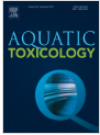Exploring the interactions between polyunsaturated fatty acids and cadmium in rainbow trout liver cells: a genetic and proteomic study

Scientific abstract
Polyunsaturated fatty acids (PUFAs) have key biological roles in fish cells. We recently showed that the phospholipid composition of rainbow trout liver cells (RTL-W1 cell line) modulates their tolerance to an acute cadmium (Cd) challenge. Here, we investigated (i) the extent to which PUFAs and Cd impact fatty acid homeostasis and metabolism in these cells and (ii) possible mechanisms by which specific PUFAs may confer cytoprotection against Cd. First, RTL-W1 cells were cultivated for one week in growth media spiked with 50 μmol L−1 of either alpha-linolenic acid (ALA, 18:3n-3), eicosapentaenoic acid (EPA, 20:5n-3), linoleic acid (LA, 18:2n-6) or arachidonic acid (AA, 20:4n-6) in order to modulate their fatty acid profile. Then, the cells were challenged with Cd (0, 50 or 100 μmol L−1) for 24 h prior to assaying viability, fatty acid profile, intracellular Cd content, proteomic landscape and expression levels of genes involved in fatty acid metabolism, synthesis of PUFA-derived signalling molecules and stress response. We observed that the fatty acid supply and, to a lesser extent, the exposure to Cd influenced cellular fatty acid homeostasis and metabolism. The cellular fatty acid composition of fish liver cells modulated their tolerance to an acute Cd challenge. Enrichments in ALA, EPA, and, to a lesser extent, AA conferred cytoprotection while enrichment in LA had no impact on cell viability. The present study ruled out the possibility that cytoprotection reflects a decreased Cd burden. Our results rather suggest that the PUFA-derived cytoprotection against Cd occurs through a reduction of the oxidative stress induced by Cd and a differential induction of the eicosanoid cascade, with a possible role of peroxiredoxin and glutaredoxin (antioxidant enzymes) as well as cytosolic phospholipase A2 (enzyme initiating the eicosanoid cascade).
Full reference (link):
Ferain, A., Bonnineau, C.,Neefs, I., De Saeyer, N., Lemaire, B., Cornet, V.,Larondelle, Y., De Schamphelaere, K.A.C., Debier, C., Rees, J.-F., (2018). Exploring the interactions between polyunsaturated fatty acids and cadmium in rainbow trout liver cells: a genetic and proteomic study. Aquatic Toxicology, 205: 100-113.
